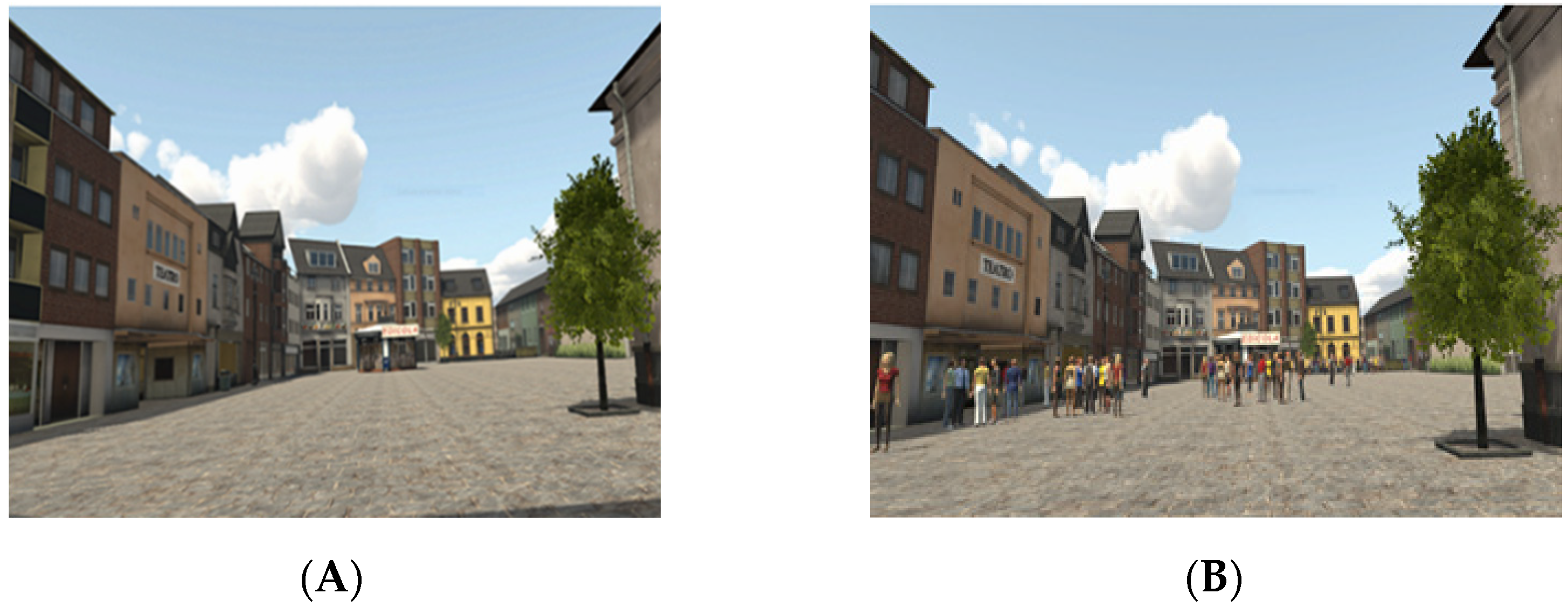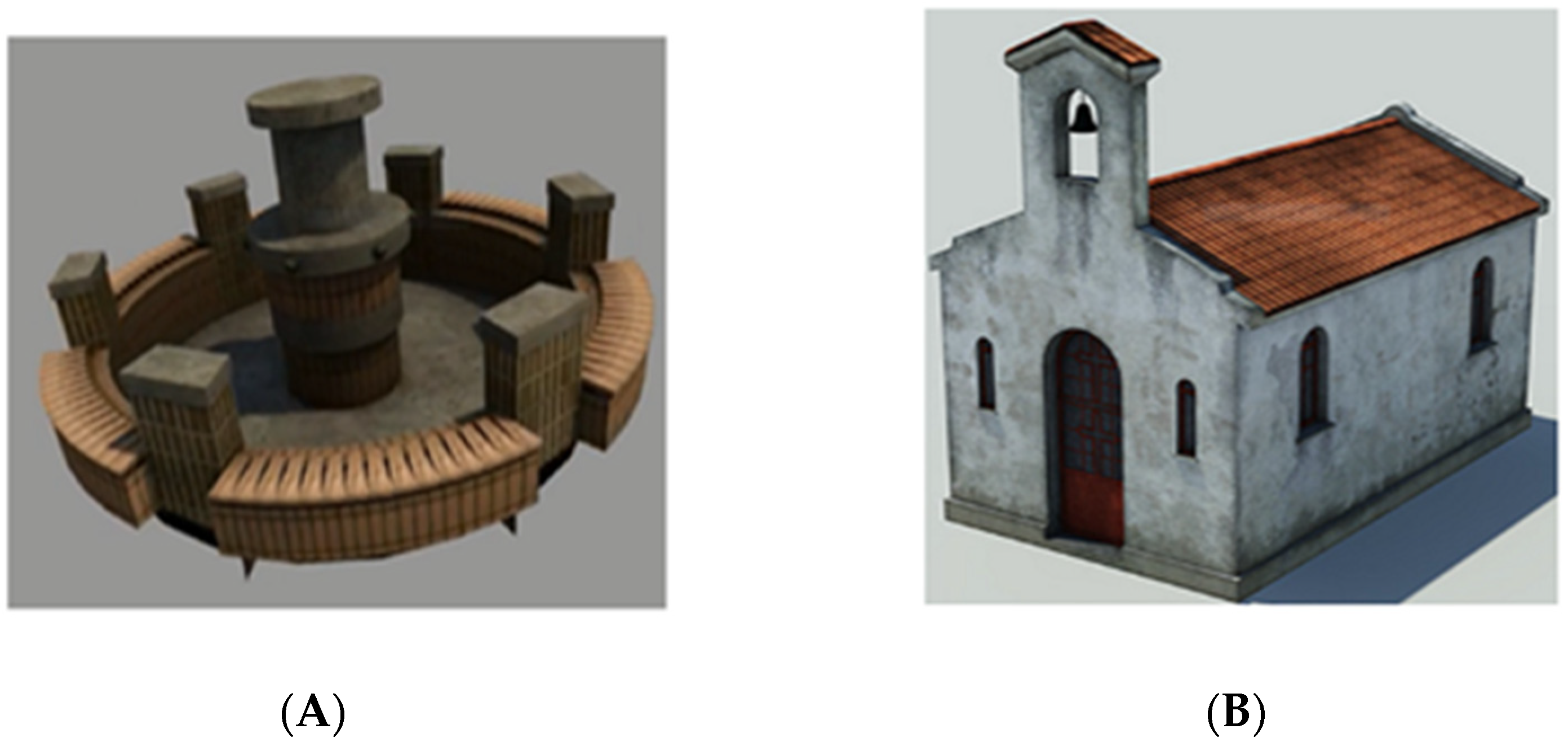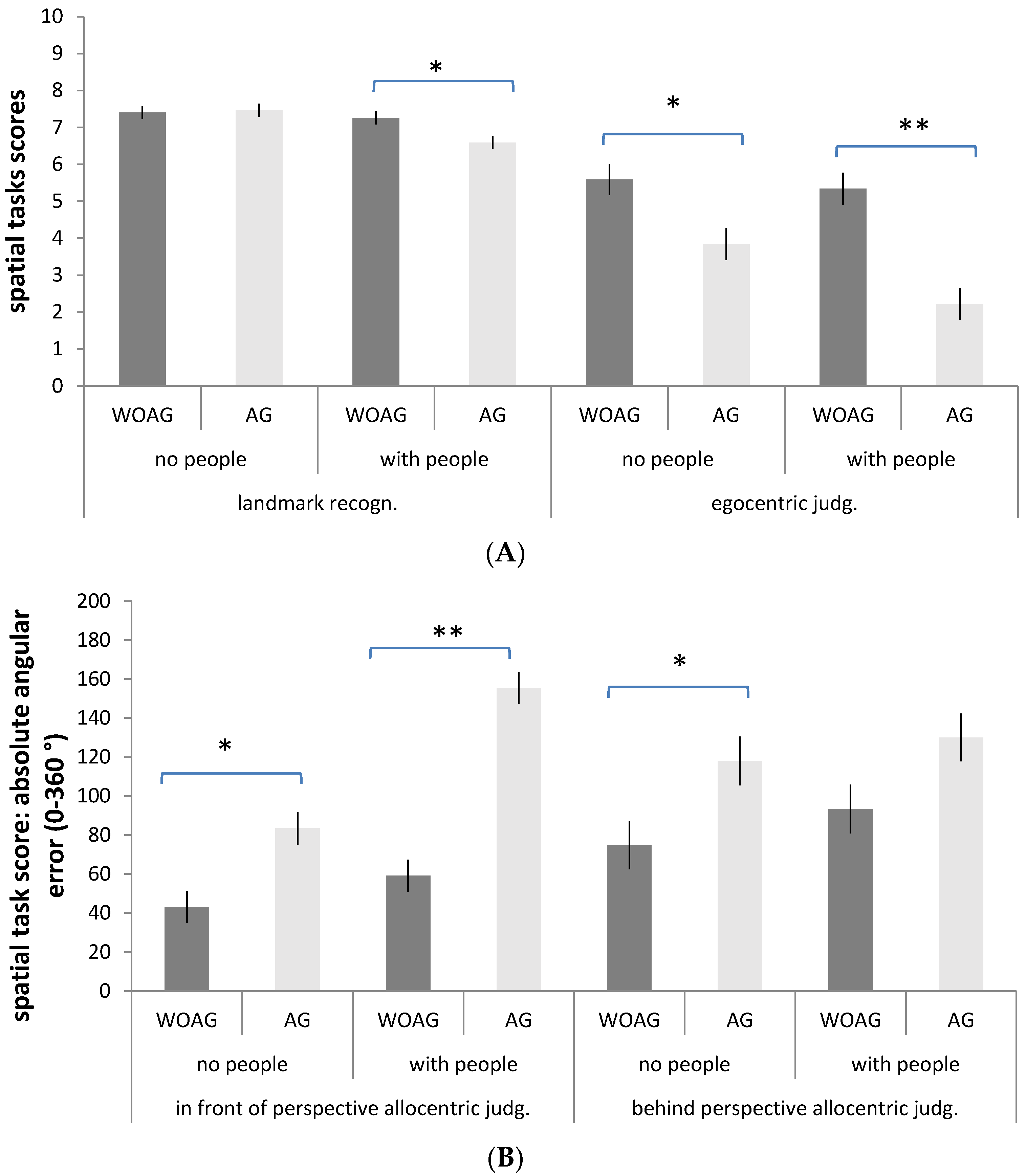The Fear to Move in a Crowded Environment. Poor Spatial Memory Related to Agoraphobic Disorder
Abstract
:1. Introduction
2. Materials and Methods
2.1. Participants
2.2. Stimuli and Experimental Conditions
2.2.1. The Agoraphobic Cognitions Questionnaire (ACQ)
2.2.2. The Mobility Inventory for Agoraphobia (MIA)
2.2.3. The Subjective Units of Distress Scale (SUDS)
2.2.4. The Computer Use Questionnaire (CUQ)
2.2.5. The Corsi Blocks Task (CBT)
2.2.6. The Virtual Reality Environment
2.2.7. Spatial Tasks
2.3. Procedure
2.4. Data Analysis
3. Results
3.1. Demographics
3.2. Spatial Tasks (Landmark Recognition, Egocentric Judgement Scores and Allocentric Judgement Scores)
3.3. Repeated Measures ANOVA with Allocentric Judgements
3.4. VSWM Test: Forward and Backward Corsi Blocks Task
3.5. Mediation Analysis
3.6. SUDS
4. Discussion
5. Conclusions
Author Contributions
Funding
Institutional Review Board Statement
Informed Consent Statement
Data Availability Statement
Conflicts of Interest
References
- Klein, N.F.; Gorman, J.M. A model of panic and agoraphobic development. Acta Psychiatr. Scand. 1987, 76, 87–95. [Google Scholar] [CrossRef]
- Marks, I.M. Fears, Phobias, and Rituals: Panic, Anxiety, and Their Disorders; Oxford University Press: Oxford, UK, 1987. [Google Scholar]
- American Psychiatric Association. Diagnostic and Statistical Manual of Mental Disorders, 5th ed.; American Psychiatric Association: Arlington, VA, USA, 2013. [Google Scholar]
- Francis, J.L.; Wiesberg, R.B.; Dyck, I.R.; Culpepper, L.; Smith, K.; Edelen, M.O.; Keller, M.B. Characteristics and Course of Panic Disorder and Panic Disorder with Agoraphobia in Primary Care Patients. Prim. Care Companion J. Clin. Psychiatry 2007, 9, 173–179. [Google Scholar] [CrossRef] [PubMed] [Green Version]
- Salhotra, N.; Bhattacharyya, D.; Wadhawan, J.M.; Yadav, P. Sociodemographic and Clinical Variables related to Panic Disorder with and without Agoraphobia. J. Clin. Diagn. Res. 2018, 12, 4. [Google Scholar] [CrossRef]
- Lawton, C.A.; Morrin, K.A. Gender Differences in Pointing Accuracy in Computer-Simulated 3D Mazes. Sex Roles 1999, 40, 73–92. [Google Scholar] [CrossRef]
- Lawton, C.A.; Kallai, J. Gender Differences in Wayfinding Strategies and Anxiety About Wayfinding: A Cross-Cultural Comparison. Sex Roles 2002, 47, 389–401. [Google Scholar] [CrossRef]
- Nori, R.; Grandicelli, S.; Giusberti, F. Individual Differences in Visuo-Spatial Working Memory and Real-World Wayfinding. Swiss J. Psychol. 2009, 68, 7–16. [Google Scholar] [CrossRef]
- Brunsdon, R.; Nickels, L.; Coltheart, M. Topographical disorientation: Towards an integrated framework for assessment. Neuropsychol. Rehabil. 2007, 17, 34–52. [Google Scholar] [CrossRef]
- Wolbers, T.; Hegarty, M. What determines our navigational abilities? Trends Cogn. Sci. 2010, 14, 138–146. [Google Scholar] [CrossRef] [PubMed]
- Easton, R.D.; Sholl, M.J. Object-array structure, frames of reference, and retrieval of spatial knowledge. J. Exp. Psychol. Learn. Mem. Cogn. 1995, 21, 483–500. [Google Scholar] [CrossRef] [PubMed]
- Burgess, N. Spatial Cognition and the Brain. Ann. N. Y. Acad. Sci. 2008, 1124, 77–97. [Google Scholar] [CrossRef]
- Avraamides, M.N.; Kelly, J.W. Multiple systems of spatial memory and action. Cogn. Process. 2007, 9, 93–106. [Google Scholar] [CrossRef] [PubMed]
- Mou, W.; McNamara, T.P.; Valiquette, C.M.; Rump, B. Allocentric and Egocentric Updating of Spatial Memories. J. Exp. Psychol. Learn. Mem. Cogn. 2004, 30, 142–157. [Google Scholar] [CrossRef] [PubMed]
- Logie, R.H. Essays in Cognitive Psychology. Visuo-Spatial Working Memory; Lawrence Erlbaum Associates, Inc.: Mahwah, NJ, USA, 1995. [Google Scholar]
- Muffato, V.; de Beni, R. Path Learning from Navigation in Aging: The Role of Cognitive Functioning and Wayfinding Inclinations. Front. Hum. Neurosci. 2020, 14, 8. [Google Scholar] [CrossRef]
- Lawton, C.A. Strategies for indoor wayfinding: The role of orientation. J. Environ. Psychol. 1996, 16, 137–145. [Google Scholar] [CrossRef]
- Davis, R.L.; Therrien, B.A.; West, B.T. Working Memory, Cues, and Wayfinding in Older Women. J. Appl. Gerontol. 2009, 28, 743–767. [Google Scholar] [CrossRef]
- Bianchini, F.; di Vita, A.; Palermo, L.; Piccardi, L.; Blundo, C.; Guariglia, C. A Selective Egocentric Topographical Working Memory Deficit in the Early Stages of Alzheimer’s Disease. Am. J. Alzheimer’s Dis. Other Dement. 2014, 29, 749–754. [Google Scholar] [CrossRef]
- Coluccia, E.; Louse, G. Gender differences in spatial orientation: A review. J. Environ. Psychol. 2004, 24, 329–340. [Google Scholar] [CrossRef]
- Andersson, U. Working memory as a predictor of written arithmetical skills in children: The importance of central executive functions. Br. J. Educ. Psychol. 2008, 78, 181–203. [Google Scholar] [CrossRef]
- Kállai, J. Restructuring of attention fixation of agoraphobic subjects in real life situation. In Proceedings of the 18th Annual Congress of the European Association of Behaviour Therapy, Vienna, Austria, 20–22 September 1989. [Google Scholar]
- Kállai, J.; Kóczán, G.; Szabó, I.; Molnar, P.; Varga, J. An Experimental Study to Operationally Define and Measure Spatial Orientation in Panic Agoraphobic Subjects, Generalized Anxiety and Healthy Control Groups. Behav. Cogn. Psychother. 1995, 23, 145–152. [Google Scholar] [CrossRef]
- Kallai, J.; Karádi, K.; Bereczkei, T.; Rózsa, S.; Jacobs, W.J.; Nadel, L. Spatial exploration behaviour in an extended labyrinth in patients with panic disorder and agoraphobia. Psychiatry Res. 2007, 149, 223–230. [Google Scholar] [CrossRef]
- Jones, R.B.; Humphris, G.; Lewis, T. Do agoraphobics interpret the environment in large shops and supermarkets differently? Br. J. Clin. Psychol. 1996, 35, 635–637. [Google Scholar] [CrossRef]
- Kállai, J.; Kosztolányi, P.; Osváth, A.; Jacobs, W.J. Attention fixation training: Training people to form cognitive maps help to control symptoms of panic disorder with agoraphobia. J. Behav. Ther. Exp. Psychiatry 1999, 30, 273–288. [Google Scholar] [CrossRef]
- Gorini, A.; Schruers, K.; Riva, G.; Griez, E. Nonhomogeneous results in place learning among panic disorder patients with agoraphobia. Psychiatry Res. 2010, 179, 297–305. [Google Scholar] [CrossRef]
- Morris, R.G. Spatial localization does not require the presence of local cues. Learn. Motiv. 1981, 12, 239–260. [Google Scholar] [CrossRef]
- Vincelli, F.; Anolli, L.M.; Bouchard, S.; Wiederhold, B.K.; Zurloni, V.; Riva, G. Experiential Cognitive Therapy in the Treatment of Panic Disorders with Agoraphobia: A Controlled Study. CyberPsychology Behav. 2003, 6, 321–328. [Google Scholar] [CrossRef] [Green Version]
- Cimadevilla, J.M.; Lizana, J.R.; Roldán, M.D.; Cánovas, R.; Rodríguez, E. Spatial memory alterations in children with epilepsy of genetic origin or unknown cause. Epileptic Disord. 2014, 16, 203–207. [Google Scholar] [CrossRef] [Green Version]
- Lokka, I.E.; Çöltekin, A.; Wiener, J.; Fabrikant, S.I.; Röcke, C. Virtual environments as memory training devices in navigational tasks for older adults. Sci. Rep. 2018, 8, 10809. [Google Scholar] [CrossRef]
- Grant, S.C.; Magee, L.E. Contributions of Proprioception to Navigation in Virtual Environments. J. Hum. Factors Ergon. Soc. 1998, 40, 489–497. [Google Scholar] [CrossRef]
- Piccardi, L. Representational neglect and navigation in virtual space. Cogn. Neuropsychol. 2009, 26, 247–265. [Google Scholar] [CrossRef]
- Chambless, D.L.; Caputo, G.C.; Jasin, S.E.; Gracely, E.J.; Williams, C. The Mobility Inventory for Agoraphobia. Behav. Res. Ther. 1985, 23, 35–44. [Google Scholar] [CrossRef]
- Chambless, D.L.; Caputo, G.C.; Bright, P.; Gallagher, R. Assessment of fear of fear in agoraphobics: The Body Sensations Questionnaire and the Agoraphobic Cognitions Questionnaire. J. Consult. Clin. Psychol. 1984, 52, 1090–1097. [Google Scholar] [CrossRef]
- Chambless, D.L.; Sharpless, B.A.; Rodriguez, D.; McCarthy, K.S.; Milrod, B.L.; Khalsa, S.-R.; Barber, J.P. Psychometric Properties of the Mobility Inventory for Agoraphobia: Convergent, Discriminant, and Criterion-Related Validity. Behav. Ther. 2011, 42, 689–699. [Google Scholar] [CrossRef] [Green Version]
- Lawton, C.A. Gender, spatial abilities, and wayfinding. In Handbook of Gender Research in Psychology; Chrisler, J.C., McCreary, D.R., Eds.; Springer: New York, NY, USA, 2010; pp. 317–341. [Google Scholar]
- Antonietti, A. Computer Use Questionnaire, 1998. Available online: www.eden.bme.hu/CodeSig/home.htm (accessed on 15 June 2018).
- Lugli, L.; Ragni, M.; Piccardi, L.; Nori, R. Hypermedia navigation: Differences between spatial cognitive styles. Comput. Hum. Behav. 2017, 66, 191–200. [Google Scholar] [CrossRef]
- Faul, F.; Erdfelder, E.; Lang, A.-G.; Buchner, A. G*Power 3: A flexible statistical power analysis program for the social, behavioral, and biomedical sciences. Behav. Res. Methods 2007, 39, 175–191. [Google Scholar] [CrossRef] [PubMed]
- Wolpe, J. The Practice of Behavior Therapy; Pergamon Press: New York, NY, USA, 1969. [Google Scholar]
- Kim, D.; Bae, H.; Park, Y.C. Validity of the Subjective Units of Disturbance Scale in EMDR. J. EMDR Pr. Res. 2008, 2, 57–62. [Google Scholar] [CrossRef]
- Corsi, P.M. Human Memory and the Medial Temporal Region of the Brain. Ph.D. Thesis, McGill University, Montreal, QC, Canada, 1972. [Google Scholar]
- Spinnler, H.; Tognoni, G. Standardizzazione e Taratura Italiana di Test Neuropsicologici. Ital. J. Neurol. Sci. 1987, 6, 44–46. [Google Scholar]
- Monaco, M.; Costa, A.; Caltagirone, C.; Carlesimo, G.A. Forward and backward span for verbal and visuo-spatial data: Standardization and normative data from an Italian adult population. Neurol. Sci. 2013, 34, 749–754. [Google Scholar] [CrossRef] [PubMed]
- Botella, C.; García-Palacios, A.; Villa, H.; Baños, R.M.; Quero, S.; Alcañiz, M.; Riva, G. Virtual reality exposure in the treatment of panic disorder and agoraphobia: A controlled study. Clin. Psychol. Psychother. 2007, 14, 164–175. [Google Scholar] [CrossRef]
- Nori, R.; Giusberti, F. Cognitive Styles: Errors in Directional Judgments. Perception 2003, 32, 307–320. [Google Scholar] [CrossRef] [PubMed]
- Palermo, L.; Nori, R.; Piccardi, L.; Giusberti, F.; Guariglia, C. Environment and object mental images in patients with representational neglect: Two case reports. J. Int. Neuropsychol. Soc. 2010, 16, 921–932. [Google Scholar] [CrossRef] [PubMed]
- Roskos-Ewoldsen, B.; McNamara, T.P.; Shelton, A.L.; Carr, W. Mental representations of large and small spatial layouts are orientation dependent. J. Exp. Psychol. Learn. Mem. Cogn. 1998, 24, 215–226. [Google Scholar] [CrossRef] [PubMed]
- Qualtrics Company, Provo, Utah, USA 2005. Available online: https://www.qualtrics.com (accessed on 20 June 2018).
- Palermo, L.; Bianchini, F.; Iaria, G.; Tanzilli, A.; Guariglia, C. Assessing Topographical Orientation Skills in Cannabis Users. Sci. World J. 2012, 7, 137071. [Google Scholar] [CrossRef] [Green Version]
- George, D.; Mallery, M. SPSS for Windows Step by Step: A Simple Guide and Reference, 17.0 Update, 10th ed.; Pearson: Boston, MA, USA, 2010. [Google Scholar]
- Howitt, D.; Cramer, D. Introduction to Research Methods in Psychology; Pearson Prentice Hall: New York, NY, USA, 2005. [Google Scholar]
- Kallai, K.; Karadi, K.; Kovacs, B. Influence of fear and anxiety on organisation of way-finding and spatial orientation. Psychol. Rev. 2000, 7, 27–35. [Google Scholar]
- Vecchi, T.; Richardson, J.T. Measures of visuospatial short-term memory: The knox cube imitation test and the corsi blocks test compared. Brain Cogn. 2001, 46, 291–294. [Google Scholar] [CrossRef]
- Vandierendonck, A.; Szmalec, A. An Asymmetry in the Visuo-Spatial Demands of Forward and Backward Recall in the Corsi Blocks Task. Imagin. Cogn. Pers. 2003, 23, 225–231. [Google Scholar] [CrossRef]
- Della Sala, S.; Gray, C.; Baddeley, A.; Allamano, N.; Wilson, L. Pattern span: A tool for unwelding visuo-spatial memory. Neuropsychologia 1999, 37, 1189–1199. [Google Scholar] [CrossRef]
- Logie, R.H. Spatial and Visual Working Memory: A Mental Workspace in The Psychology of Learning and Motivation: Advances in Research and Theory: Cognitive Vision, 42; Academic Press Inc.: San Diego, CA, USA, 2003; pp. 37–78. [Google Scholar]
- Keogh, E.; French, C.C. The effect of trait anxiety and mood manipulation on the breadth of attention. Eur. J. Pers. 1999, 13, 209–223. [Google Scholar] [CrossRef]
- Waller, D.; Montello, D.R.; Richardson, A.E.; Hegarty, M. Orientation specificity and spatial updating of memories for layouts. J. Exp. Psychol. Learn. Mem. Cogn. 2002, 28, 1051–1063. [Google Scholar] [CrossRef]
- Santoro, I.; Murgia, M.; Sors, F.; Agostini, T. Walking reduces the gap between encoding and sensorimotor alignment effects in spatial updating of described environments. Q. J. Exp. Psychol. 2017, 70, 750–760. [Google Scholar] [CrossRef]
- Sweller, J. Cognitive load during problem solving: Effects on learning. Cogn. Sci. 1988, 12, 257–285. [Google Scholar] [CrossRef]
- Sweller, J. Cognitive load theory: Recent theoretical advances. In Cognitive Load Theory; Plass, J.L., Moreno, R., Brünken, E., Eds.; Cambridge University Press: Cambridge, UK, 2010; pp. 29–47. [Google Scholar]
- Sweller, J. Cognitive load theory, learning difficulty, and instructional design. Learn. Instr. 1994, 4, 295–312. [Google Scholar] [CrossRef]
- Sweller, J.; Chandler, P. Why Some Material Is Difficult to Learn. Cogn. Instr. 1994, 12, 185–233. [Google Scholar] [CrossRef]
- North, M.M.; North, S.M.; Coble, J.R. Effectiveness of Virtual Environment Desensitization in the Treatment of Agoraphobia. Presence Teleoperators Virtual Environ. 1996, 5, 346–352. [Google Scholar] [CrossRef]
- Vincelli, F.; Riva, G.; Molinari, E. Come si cura il panico con la Realtà Virtuale: La Terapia Cognitivo-Esperienziale. In La Realtà Virtuale in Psicologia Clinica. Nuovi Percorsi di Intervento nel Disturbo di Panico con Agoraphobia; McGraw-Hill: Milano, Italy, 2007; pp. 133–178. [Google Scholar]




| Independent Variable | Mediator Variable | Dependent Variable | Sobel’s | Bootstrap [95% CI] |
|---|---|---|---|---|
| Group (1 = group with agoraphobia vs. −1 = control group) | Visuo-spatial working memory | Landmark recognition | −1.99 * | −0.08 [CI: −0.19, −0.01] |
| Group (1 = group with agoraphobia vs. −1 = control group) | Visuo-spatial working memory | Egocentric judgements | −2.18 * | −0.21 [CI: −0.46, −0.07] |
| Group (1 = group with agoraphobia vs. −1 = control group) | Visuo-spatial working memory | In front of the participant imagined perspective allocentric judgements | 2.99 * | 8.17 [CI: 3.71, 14.50] |
| Group (1 = group with agoraphobia vs. −1 = control group) | Visuo-spatial working memory | Behind the participant imagined perspective allocentric judgements | 2.38 * | 6.99 [CI: 2.24, 15.20] |
Publisher’s Note: MDPI stays neutral with regard to jurisdictional claims in published maps and institutional affiliations. |
© 2021 by the authors. Licensee MDPI, Basel, Switzerland. This article is an open access article distributed under the terms and conditions of the Creative Commons Attribution (CC BY) license (https://creativecommons.org/licenses/by/4.0/).
Share and Cite
Zucchelli, M.M.; Piccardi, L.; Nori, R. The Fear to Move in a Crowded Environment. Poor Spatial Memory Related to Agoraphobic Disorder. Brain Sci. 2021, 11, 796. https://doi.org/10.3390/brainsci11060796
Zucchelli MM, Piccardi L, Nori R. The Fear to Move in a Crowded Environment. Poor Spatial Memory Related to Agoraphobic Disorder. Brain Sciences. 2021; 11(6):796. https://doi.org/10.3390/brainsci11060796
Chicago/Turabian StyleZucchelli, Micaela Maria, Laura Piccardi, and Raffaella Nori. 2021. "The Fear to Move in a Crowded Environment. Poor Spatial Memory Related to Agoraphobic Disorder" Brain Sciences 11, no. 6: 796. https://doi.org/10.3390/brainsci11060796
APA StyleZucchelli, M. M., Piccardi, L., & Nori, R. (2021). The Fear to Move in a Crowded Environment. Poor Spatial Memory Related to Agoraphobic Disorder. Brain Sciences, 11(6), 796. https://doi.org/10.3390/brainsci11060796







